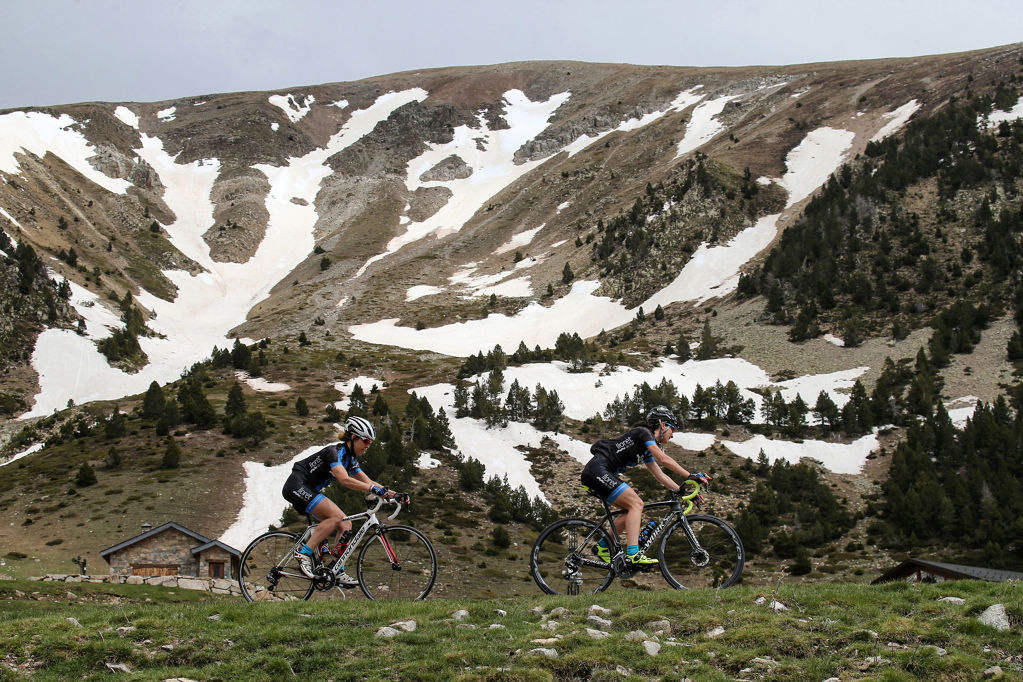
Sant Esteve d'en Bas - Oix - Beget - Vallter - Sant Esteve d'en Bas
Sant Esteve d'en Bas - Oix - Beget - Vallter - Sant Esteve d'en Bas
Transfer needed 60'
 Distance:
150 km
Distance:
150 km
 Elevation gain:
2.616 m
Elevation gain:
2.616 m
 Max. Elevation:
2.151 m
Max. Elevation:
2.151 m
Water points
- Sant Esteve d’en Bas
- Castellfollit de la Roca
- Oix
- Beget
- Rocabruna
- Camprodon
- Setcases
- Sant Pau de Segúries
- La Canya

|
MOUNTAIN PASSES |
CATEGORY |
DISTANCE |
ELEV. CHANGE |
AVERAGE % |
MAX. GRADE |
||
|
Coll de Bucs |
2 |
7,8 km |
4,90 mi |
404 m |
1.325,45 ft |
5,2% |
13% |
|
Coll de Boixeda |
2 |
12,1 km |
7,5 mi |
652 m |
2.139,11 ft |
5% |
12% |
|
Vallter 2000 |
HC |
12,1 km |
7,5 mi |
886 m |
2906,82 ft |
7,3% |
14% |
|
SECTIONS WITH TRAFFIC DENSITY / ROAD SURFACE DEFECTS |
HIGH DENSITY |
MEDIUM DENSITY |
LOW DENSITY |
|
Sant Esteve - Olot - Beget - Camprodon |

Secondary road |
||
|
Camprodon - Setcases |

Not very dense urban and inter-urban section |
||
|
Setcases - Vallter |
|||
|
Vallter - Sant Pau de Segúries |

Not very dense urban and inter-urban section |
||
|
Sant Pau - Capsacosta |

Secondary road |
||
|
Crossroads of C-153 G1 - Sant Esteve d’en Bas |

Secondary road |
We depart from the car park of the municipal swimming pool of Sant Esteve d’en Bas, right by the Olot – Sant Feliu de Guíxols Greenway. There’s plenty of parking available here, along with a bar-restaurant and, of course, the municipal swimming pool if you fancy cooling off after the ride.
We take the virtually traffic-free secondary roads of the Vall d’en Bas area, ending up on the GI-522 road to Castellfollit de la Roca. Here we come to a crossroads with the road that takes us to Oix: a quiet, constantly undulating road. Once we reach Oix, we’re ready for the first challenge of the day’s mountain passes, a short but sharp challenge that gives us a chance to enjoy the wonderful landscape we’re riding through.
A rapid descent takes us to Beget, a town worth visiting, before taking on the second mountain pass of the route: the Boixeda Pass, longer but not as tough. We pass through Rocabruna and, a few kilometres further on, reach the top of the Boixeda Pass. A rapid descent leads us to Camprodon, where we take the GIV-5264 road in the direction of Setcases.
From this point (although the climb up to the mountain pass has not yet begun) it’s uphill all the way. We pass through Setcases before taking on the day’s mightiest climb: Vallter 2000. The ascent begins with some very tough slopes as we leave the village and some false flats as we make our way up to the top of the Vallter ski resort, at 2,151 metres above sea level. Vallter has been chosen on several occasions as the final stage for professional races and cycle tours alike.
We go back on ourselves to Camprodon, where we take the C-151-G road in the direction of Sant Pau de Segúries. Here we take the road of the Capsacosta Pass, a magnificent descent down to the C-153 G1 road that will take us to Olot. Just as we reach La Canya, we take the N-260 road to Olot Hospital, where we then take the GIP-5223 secondary road that takes us back to the departure point of the route.
This route is not recommended in the winter months. Cyclists must bear in mind that the weather can change quickly high up in the mountains and should be equipped accordingly.
Points of interest
Castellfollit de la Roca: small, picturesque town in the county of Garrotxa, set on a crag. It forms part of the Natural Park of the Garrotxa Volcanic Zone. With a surface area of less than 1 km2, it’s one of the smallest towns in Catalonia.
Beget: small village with a mediaeval feel, located at the head of the Llierca River. Its stone houses are scattered around the Beget Stream.
Camprodon: a classic mountain destination for the summer holidaymakers of the Catalan bourgeoisie in the 19th century. Striking residential properties from this period have been preserved. Camprodon makes a good base for enjoying nature activities in the county of Ripollès.
Setcases: a well-preserved high mountain village that blends in perfectly with the landscape. Visitors can now bathe at a small beach close to the source of the Ter River.
Vallter 2000: a downhill ski resort in the winter and a leading resort for cross-country skiing. It’s also popular with hikers in the summer, being a great starting point for many hikes and excursions. It has a mountain shelter: Ull de Ter.